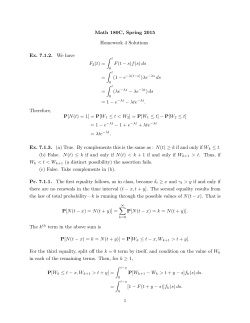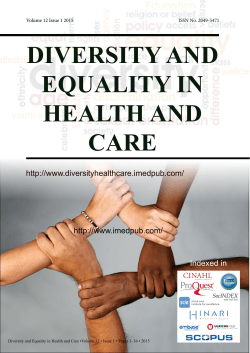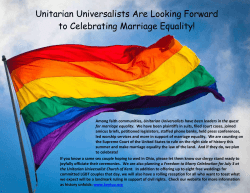
CLT Report - Corporate Equality Action Plan
Cabinet 16th March 2015 REPORT TO: AGENDA ITEM: 14 SUBJECT: Interim Equality and Inclusion Policy (2014-2016) LEAD OFFICER: CABINET MEMBER: Sarah Ireland Strategy, community and commissioning Councillor Mark Watson Cabinet Member for Safety, Justice and Communities WARDS: CORPORATE PRIORITY/POLICY CONTEXT: All The development of an Equality and Inclusion Policy sets out the Council’s ambition to make Croydon a place of opportunity and fairness. AMBITIOUS FOR CROYDON AND WHY ARE WE DOING THIS: This policy supports the Council’s ambition to reduce inequality and promote opportunity and fairness for all of our communities by working with partners in the public, business and voluntary sectors in order to secure better outcomes for all. FINANCIAL IMPACT: Utilisation of existing budget to deliver the policy. KEY DECISION REFERENCE NO: This is not a key executive decision. As part of the core policy framework it is reserved to Council for decision. The Leader of the Council has delegated to the Cabinet the power to make the decisions set out in the recommendations below 1. RECOMMENDATION Cabinet is asked to recommend to Full Council that it agrees the Interim Equality and Inclusion Policy 2015-16 found at appendix one. 1 2. EXECUTIVE SUMMARY 2.1 The interim Equality and Inclusion Policy 2014 - 16 found at appendix one sets out a new direction for the administration demonstrating its commitment to equality and its ambition to narrow the gaps in outcomes for the residents of Croydon. 2.2 A key part of this commitment has involved commissioning an independent Opportunity and Fairness commission to lead work on defining and informing future objectives that will have an impact on tackling inequality in the borough. 2.3 The Commission will examine the issues of inequality in the borough, collate relevant evidence, undertake extensive engagement with local people and make recommendations to the council and its partners. These will consider how the Council and other organisations (public, private as well as the community and voluntary sector) can use their roles and influence, both individually and collectively, to reduce inequalities and increase the perception and experience of fairness within the local economy and local communities. 2.4 Once the Commission findings and recommendations have been considered by the Council and its partners the interim Equality and Inclusion Policy will be updated to reflect the borough’s longer term outcomes and set new statutory equality objectives in line with the Council’s statutory obligation and specific duties found in the Equality Act 2010. 3. BACKGROUND 3.1 The Equality Act 2010 and the Public Sector Equality Duty (PSED) 3.1.1 Section 149 of the Equality Act 2010 (the Act) contains the Public Sector Equality Duty (PSED) that applies to public bodies and others carrying out a public function. It contains nine characteristics that are protected in law and these include age, gender, disability, race, religion and/or belief, sexual orientation, pregnancy and maternity, marriage and civil partnership, and gender reassignment. 3.1.2 The Act and PSED support good decision-making by ensuring that the Council as a public body considers how different people will be affected by their activities by developing policies and delivering services which are efficient and effective; accessible to all; and which meet different people’s needs. 3.1.3 Further details on the PSED can be found at pages 3-6 of the Equality and Inclusion Policy 2014-16 found at appendix one. 4. EQUALITY AND INCLUSION POLICY 2014-16 4.1 The proposed interim Equality and Inclusion Policy (2014-16) is found at appendix one. The Policy proposes six over-arching and cross-cutting equality and inclusion priorities and sets out the administration’s strategic ambition for the equality and inclusion agenda. It also provides an overview of the Council’s direction of travel for planning and delivering fair, accessible and resident-focused services that aim to 2 address issues of community cohesion, social exclusion and inequality including closing the gaps in outcomes found at appendix two. 4.2 The equality and inclusion priorities are summarised below: 1 Make Croydon a place of opportunity and fairness by tackling inequality, disadvantage and exclusion. 2 Foster good community relations and cohesion by getting to know our diverse communities and understand their needs. 3 Encourage local people to be independent and resilient by providing responsive and accessible services and offering excellent customer care. 4 Improve empowerment and participation by strengthening partnership work with the community, faith and voluntary sectors. 5 Provide strong leadership, partnership and organisational commitment by enabling staff and communities to find solutions to the things that matter most to them. 6 Become an employer of choice by recruiting, developing and retaining an efficient, talented and motivated workforce that broadly reflects the communities that we serve at all levels. 4.3 These priorities will also enable the Council to work with partners in the public, community, voluntary and business sectors to deliver the highest standard of equalities and inclusion practice and secure better outcomes for local people. 4.4 The Council intends to ensure that equality performance and analysis is explicitly integrated into existing sources of published information. In January 2015, cabinet agreed a new set of outcomes and performance measures that underpin this equality and inclusion policy called Ambitious for Croydon. More information about the Council’s outcomes and indicators can be found at www.croydon.gov.uk 4.5 Equality analysis of geographic inequality and that related to people who share a protected characteristic and those who do not will be embedded in the borough profile to be published by the autumn 2015. Further information about thematic inequalities will be found in borough-wide documents such as the annual health report, crime analysis or workforce profile. In addition the council’s programme of equality analysis will provide evidence of need relating to specific policies and published with the relevant reports, where appropriate and appropriate to do so. 5. EQUALITY FRAMEWORK FOR LOCAL GOVERNMENT (EFLG) 5.1 The Council’s ambition is to be recognised for excellent equality policy and practice. The proposed equality and inclusion priorities have been closely aligned to the strategic themes of the Equality Framework for Local Government (EFLG). The EFLG is a national benchmark that many local authorities and other public bodies 3 use to measure their organisational performance on equality and inclusion and put in place improvement plans. 5.2 The EFLG consists of five cross-cutting and performance driven principles which align with the PSED. These are: Knowing your communities Leadership, partnership and organisational commitment Community engagement and satisfaction Responsive services and customer care A skilled and committed workforce It has three levels of achievement; ‘developing’, ‘achieving’ and ‘excellent’. 5.3. The EFLG principles are at the centre of the Council’s equality and inclusion policy. They have been adopted and translated into our equality objectives which provide a framework to manage performance and service improvement across the council and the Local Strategic Partnership. They will also enable Croydon Council to continue its journey to be an excellent authority for all of its communities. 5.4 In order to develop the Council’s Equality and Inclusion Policy and associated action plan for 2016 onwards, it is proposed that officers will complete a self -assessment exercise against the EFLG and use the gap analysis to define key areas for service improvement. 5.5 The Council is also proposing to seek external challenge and accreditation against the EFLG. This will involve an external assessment of a council’s own judgement of its performance against the Equality Framework benchmark through the “Peer Challenge” process that is managed by the Local Government Association. 5.6 The Peer Challenge is designed to validate the Council’s own self-assessment at either the “Achieving” or “Excellent” level by: A review of the authority’s self-assessment document, including supporting documentary evidence; and A two-day, on-site visit to conduct interviews and focus groups with employees, members and other stakeholders. Based on all it has learned during the Peer Challenge process, the Peer Challenge team will determine whether the award of ‘Achieving' or 'Excellent' should be made to the Council and will also feedback its decision, observations and recommendations at the end of the visit through a formal report and presentation. 6. NEXT STEPS 6.1 Subject to approval by Full Council of the interim Equality and Inclusion Policy, the strategic priorities are aligned with the Council’s new outcome framework Ambitious for Croydon and integrated into the Corporate Plan. 4 6.2 Once the Opportunity and Fairness Commission findings and recommendations have been considered by the Council the interim Equality and Inclusion Policy will be updated to reflect the council’s longer term priorities. These will inform the development of the Council’s Equality and Inclusion Policy 2016-20 in line with the statutory obligation to set four year equality objectives, accompanying action plan as well as a new set performance measures. It is proposed that the new performance measure will focus on narrowing the gaps found at appendix two. 7. CONSULTATION 7.1 A short informal consultation on the Equality and Inclusion Policy has taken place with external and internal stakeholders from November 2014 through to January 2015. This involved community and voluntary groups as well as staff providing feedback on the priorities and the proposed actions that the Council will take to address inequality and promote fairness. 7.2 The feedback from the consultation highlights the following considerations: To understand and address inequality and disadvantage in relation to different groups of people; To address the challenges that residents face in accessing services digitally and prioritise work on this as well as financial inclusion; To ensure the council’s workforce reflects the community it serves at all levels. The above mentioned issues and others expressed during the consultation period will be further explored through the engagement that will be undertaken by the Opportunity and Fairness Commission in 2015. 7.3 The Opportunity and Fairness Commission will in the course of its work carry out a series of consultation and engagement activities with stakeholders such as residents, community / voluntary groups and groups that share a “protected characteristic” in order to understand the inequality and fairness challenges for the borough. The Commission’ expects to publish its final report in January 2016. This will be used to inform the equality and inclusion statutory objectives for 2016 – 20 that will form the Equality and Inclusion Policy for this period. 8. FINANCIAL AND RISK ASSESSMENT CONSIDERATIONS 8.1 Future savings/efficiencies There are no savings or efficiencies associated with the approval of this report. (Approved by: Dianne Ellender, Head of Finance and Deputy Section 151 Officer on behalf of Director of Finance and Section 151 Officer) 9. COMMENTS OF THE COUNCIL SOLICITOR AND MONITORING OFFICER 9.1 The Council Solicitor comments that the development and implementation of this Policy will contribute to the fulfilment of the Council’s statutory duties to promote 5 equalities within the Borough. There are no direct legal implications arising from this report. (Approved by: Gabriel MacGregor, Head of Corporate Law on behalf of the Council Solicitor and Monitoring Officer) 10. HUMAN RESOURCES IMPACT 10.1 An equality priority and related measures in this policy is aligned to the Council’s People Strategy. Equality is integral to everything the council does as an organisation and in partnership with others including becoming an employer of choice. (Approved by: Adrian Prescod, HR Business Partner on behalf of Director of Human Resources) 11. EQUALITIES IMPACT 11.1 Appendix two provides an overview of key inequalities across the borough and a summary of the inclusion issues set out below: Health inequalities - including differences in life expectancy, obesity and access to good quality food that is inexpensive, physical health of people who suffer mental health concerns Poverty- differences in income, child poverty, older people’s poverty, in-work poverty, especially among women as well as food and fuel poverty Education -including attainment and lifelong learning, significant proportion of young people who leave school with no qualification Employment - including young people Not in Employment, Education or Training (NEET), unemployment, long-term unemployment, lone parents, disabled people, women, types of jobs/sectors, full-time/part-time Community safety- including hate crime and prejudice, domestic abuse and sexual violence, child sexual exploitation, bullying, trafficking, female genital mutilation, fear of crime, and confidence and trust Population change – plan and manage demographic change including ensuing new and existing communities have opportunities to integrate Housing - including homelessness, affordable homes, temporary accommodation and use of empty properties Social and civic participation - including the community, faith and voluntary sector, digital inclusion, social isolation, volunteering, voting and involvement in community activity especially among young people and women 6 Community relations, greater community response and opportunity for meaningful interaction between different groups of people 11.2 Further information and analysis of equality and inclusion in Croydon can be found at the Croydon Observatory: http://www.croydonobservatory.org/ or http://www.croydon.gov.uk/contents/departments/community/pdf/EqIAEqStrategy 11.3 A detailed equality analysis for this policy will be provided through the work of the Croydon’s Opportunity and Fairness Commission and is essentially an extensive analysis of equality and inclusion issues. The report and recommendations made by the Opportunity and Fairness Commission, supported by the qualitative and quantitative research undertaken, will act as the full equality analysis such that at this stage a further equality analysis is not considered necessary. 11.4 Any agreed recommendations from the Opportunity and Fairness Commission report will support and inform future budget decisions, the development of statutory equality objectives required by 1 April 2016, as well as the Corporate Plan and borough-wide Community Strategy. 12. ENVIRONMENTAL IMPACT 12.1 There are no implications arising directly from this report. 13. CRIME AND DISORDER REDUCTION IMPACT 13.1 The implementation of the new interim Equality and Inclusion Policy will support the Council to: Work in partnership with public sector agencies including the police, voluntary, faith and community organisations to raise awareness of and address hate crime – in particular disability, race, faith / religion and LGBT (Lesbian, Gay, Bisexual, and Transgender) hate crime. Lead on developing a coordinated partnership approach to tackle domestic abuse, sexual violence and female genital mutilation. 14. REASONS FOR RECOMMENDATIONS/PROPOSED DECISION 14.1 To support the Council demonstrate transparency and fairness in its operations as well as compliance with its public sector equality general duty and specific duties as defined by the Equality Act 2010. 15. OPTIONS CONSIDERED AND REJECTED 15.1 None CONTACT OFFICER: Sharon Godman, Head of Strategy and Community, ext. 47034 BACKGROUND DOCUMENTS: NONE 7
© Copyright 2025









